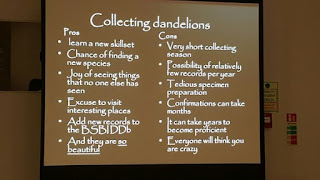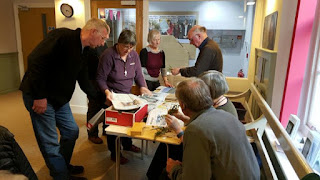 |
Small-flowered Catchfly spotted by Mick,
Kelling, North Norfolk, 2015
ID confirmed by Tim Rich via Facebook
Image: Mick Lacey |
We've been making a few updates to the BSBI website over the past few weeks and yesterday we launched the refreshed site, without any hitches and to unanimous approval. This was all fine unless you were one of the people wanting to join BSBI just as the migration process started and had to wait for 90 minutes until it had finished!
So, I nabbed the first new member to join BSBI via the new website, apologised for the brief delay and thought I'd take the opportunity to interview him for the delight of News & Views readers...
LM: Welcome to new BSBI member Mick, who joined yesterday. Do you want to tell us a bit about yourself and why you decided
to join BSBI this year?
ML: Thanks Louise, well I live in Derbyshire
but just outside the Peak District National Park and have always
had an interest in wild flowers. As a teenager I got into birding, which I
still do, but wild flowers take up more and more of my spare time. On a
recent week in North Wales I certainly spent a lot more time looking
down than up and its been like that for a few years now.
 |
Purple Ramping-fumitory spotted last week
in Conwy, Wales.
ID confirmed by Tim Rich via Facebook
Image: Mick Lacey |
LM: Ah, you've already adopted the famous "staring hopefully at the ground" stance so beloved of field botanists! And what are you particularly hoping to get out of your
membership of BSBI? Was it our field meetings that attracted you, or
opportunities to learn more about Plant ID? Or just for enjoyment, because you
love British & Irish wild flowers and care about their conservation?
ML: Just to learn more on all counts. I think that as
you learn more and get deeper into botany you realise how little you actually
do know, or that's how I feel at least. I love flower landscapes but also find
the factors affecting distribution of certain plants fascinating. I must
confess to enjoying the hunt for a new species, but the best days are finding
something that you didn't expect.
LM: I agree, spotting a plant you haven't noticed before or something growing in the "wrong" place can be just as much fun as seeing a rare plant! So how did you first hear about BSBI?
ML: I hadn't heard of the BSBI until probably the start of
last year and that was through the Facebook "Wildflowers of Britain and Ireland" page. I noticed that many of the more knowledgeable contributors were
members of the BSBI.
LM: Yes, you'll find some familiar names on our webpages and many of them can also be found on social media of an evening, helping people with plant identifications and pointing them to (free) botanical resources and BSBI Publications. But dare I ask, what
put you off joining BSBI until now?
ML: I am not sure why it's took me a year to join, possibly
because it does seem a society of very knowledgeable people, professional
botanists and I am clearly not at that level, I will only ever be an
enthusiastic amateur.
LM: Yes we do have a lot of very knowledgeable members, and they are perhaps more visible on social media, but what makes BSBI so special is that since 1836 our members have been a mixture of amateur and professional botanists, with skills ranging from beginner to expert level. And we are very keen on working together and helping each other hone our ID skills.
 |
Here's what Mick might expect to find
in his BSBI membership pack.
This pack was sent to Dave when he joined last year
and he shared this pic via Twitter.
Image: Dave Steere |
If you come along to one of our national field meetings this year, you should pick up some great ID tips from those experts. But you'll also meet absolute beginners who will be picking up ID tips from you! You may also want to check out the plant ID courses on our training page to see if any appeal to you, and I think you'll like the 'So You Want to Know Your Plants' leaflet - some very helpful pointers in there! Let us know what you think.
ML: I have already been looking through various links on the
website and it all looks very interesting. I am already looking forward to
receiving my membership pack, so thank you.
LM: Mick, thanks for talking to News & Views readers and
for joining BSBI - apologies again about the short delay! Can I invite you to come back later in the year and
give us an honest opinion on how your first year as a member is going? Tell us
what you like about BSBI and also anything you think we could do be doing
differently? A fresh pair of eyes can be really helpful, whether you're trying
to key out a plant or weighing up the value of a £30 annual subscription!
ML: Of course Louise, you are welcome.
LM: One final question, as you're the first person to join BSBI using the
form on our new website: Was the process quick and painless?
ML: It was very easy, the whole process, including
filling out the application form only took a few minutes. The hardest part was
remembering my Paypal password!
LM: And you can also use the Paypal button even if you don't have a Paypal account and password! Thanks again Mick and welcome to BSBI :-)
 The latest issue of BSBI News has been published and a print copy should be winging its way towards you very soon if you're a BSBI member.
The latest issue of BSBI News has been published and a print copy should be winging its way towards you very soon if you're a BSBI member. 




















